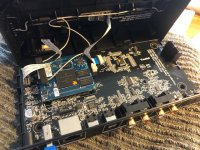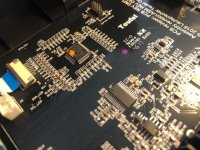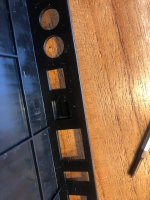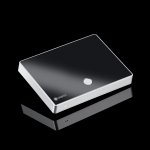Given most European households have many redundant devices sitting on a shelf while the planet needs less IT waste and as this is a DIY site, a great streamer option might be:
- old smart phone (no SIM) as the streamer connected to the WIFI with NAS to access local storage
- USB out to the DAC or out to XMOS SPDIF.
- minimalist styling
- already in a nice case
- runs cool
- silent
- good screen
- updatable app
- does high res
- gapless playback
Last edited:
Since when is a smart phone DIY? 🙂 Many will use the old smart phone as remote control to a true HiFi device which a phone in many cases simply isn't. Having to charge a phone converted to remote control is not nice, needing to charge the streamer itself is even more tedious. In practice this often will mean a phone continuously connected to a charger....together with many other devices continuously under voltage. One can ask oneself if that is all safe and green.
Please compare results of that phone to a purpose built streamer. Ha I see you edit posts after a reply just like me. Shooting at a moving target 😀
Please compare results of that phone to a purpose built streamer. Ha I see you edit posts after a reply just like me. Shooting at a moving target 😀
Last edited:
Since when is a smart phone DIY?
The DIY aspect is obviously in the implementation which is not trivial. Its still disappointing on a DIY site not to see more alternatives to buying a commercial product.
Using a smart phone as a streamer needs constant charging. I don't see why that would necessarily be unsafe.
Enough DIY devices but just not in this particular thread despite ongoing RPi attacks. The original poster was Jan Didden who clearly indicated not to want a DIY device.
Well about the constant charging... I have seen some incidents with chargers, LiPo batteries and even PS4 devices. I only want true mains switches and nothing unattended.
Well about the constant charging... I have seen some incidents with chargers, LiPo batteries and even PS4 devices. I only want true mains switches and nothing unattended.
So you unplug your fridge when you're not home? 😉
I get your point about batteries, though.
Tom
I get your point about batteries, though.
Tom
Most recent heavy incident I saw was a 2 week old PS4 that caused a hefty fire. A fridge is something different I would say. Anything with (cheap) batteries and often cheap chargers unattended is asking for trouble. Certainly when non original batteries and chargers are used as occurs with smart phones. My last personal incident was with a iPhone with swelling original battery that I brought to an Apple store where the employee quickly put it in a sturdy metal box as he said it was about to explode?! I got a new Iphone for free. The thought of an exploding iPhone in my pocket and possible loss of crown jewels made me cringe 🙂
In a company where I worked the habit was to not take the laptop computer to the home but to leave them docked 24/7. These were Dell devices. I have witnessed more than a few times that batteries overheated and made the laptop computer melt causing a fire alarm. Always in the night of course. Batteries of consumer grade stuff should only be charged attended and certainly not be charged continuously.
I have a fire brigade training every few years and every time we are trained in the in the eyes of laymen innocent "normal" habits causing severe incidents. Many of those are aforementioned habits/devices that require minimal effort to do it safely. In audio all this is avoidable by designing/using (DIY) devices with true 230V mains switches. "True power off" can't be beat with regards to safety.
In a company where I worked the habit was to not take the laptop computer to the home but to leave them docked 24/7. These were Dell devices. I have witnessed more than a few times that batteries overheated and made the laptop computer melt causing a fire alarm. Always in the night of course. Batteries of consumer grade stuff should only be charged attended and certainly not be charged continuously.
I have a fire brigade training every few years and every time we are trained in the in the eyes of laymen innocent "normal" habits causing severe incidents. Many of those are aforementioned habits/devices that require minimal effort to do it safely. In audio all this is avoidable by designing/using (DIY) devices with true 230V mains switches. "True power off" can't be beat with regards to safety.
Last edited:
What?? You mean I can't expect a safe, quality product for $1.89 including shipping? 🙂 Yeah. Some of those are scary.
I don't generally leave stuff with batteries plugged in either. The only exception is my 2010 MacBook Pro that serves as my streamer. It's now on its third battery. The last one started to swell. I'd leave it battery-less, but I travel with it for trade shows and I'm required to be able to demonstrate that it'll boot up without being plugged in during airport "security".
Tom
I don't generally leave stuff with batteries plugged in either. The only exception is my 2010 MacBook Pro that serves as my streamer. It's now on its third battery. The last one started to swell. I'd leave it battery-less, but I travel with it for trade shows and I'm required to be able to demonstrate that it'll boot up without being plugged in during airport "security".
Tom
These devices are about the least involving as far as DIY goes. My setup is just a bunch of stuff arranged inside a box, plugged into each other. If I ever make a faceplate for the cabinet, that’ll be the DIY.
Think also about the fact that the first calculator was $400, and how ten years later, they were $10. I think audio streaming devices are about to cost next to nothing or even free with the subscription to a service. To have paid $2000 for something like this must be a sign of truly disposable income.
Think also about the fact that the first calculator was $400, and how ten years later, they were $10. I think audio streaming devices are about to cost next to nothing or even free with the subscription to a service. To have paid $2000 for something like this must be a sign of truly disposable income.
Received the Teufel Streamer (3rd and current generation of Teufel Raumfeld streamers after the Connector 1 and 2). Nice and fast device with regards to operation, haven't listened yet as I had other things to do. It seems to have a StreamUnlimited 810 module with iMX7 dual core Cortex A7 ARM CPU.
https://www.streamunlimited.com
It "sees" all files on local storage pretty fast too. Setup was easy and caused no irritation. The app is quite OK which surprised me as I am used to Roon Essentials which is a level up compared to most others. The firmware menu and settings seem logically arranged and posed no question marks. It immediately wanted to update to firmware 2.16.3. Touch buttons seem superfluous to me. A bog standard 5V 2.4A SMPS wall wart is included so it will be tested with that SMPS and of course a linear PSU. LAN port is 100 Mbit max. Despite other written information it does support 24/192. Contrary to many other devices registration and/or logging in is not necessary.
No Roon support but now Roon also changed to subscription model only I am not so sure if that is a showstopper. That is a personal thing, I detest any subscription model that presents itself as a recurring monthly fee.
https://www.streamunlimited.com
It "sees" all files on local storage pretty fast too. Setup was easy and caused no irritation. The app is quite OK which surprised me as I am used to Roon Essentials which is a level up compared to most others. The firmware menu and settings seem logically arranged and posed no question marks. It immediately wanted to update to firmware 2.16.3. Touch buttons seem superfluous to me. A bog standard 5V 2.4A SMPS wall wart is included so it will be tested with that SMPS and of course a linear PSU. LAN port is 100 Mbit max. Despite other written information it does support 24/192. Contrary to many other devices registration and/or logging in is not necessary.
No Roon support but now Roon also changed to subscription model only I am not so sure if that is a showstopper. That is a personal thing, I detest any subscription model that presents itself as a recurring monthly fee.
Last edited:
“Horses for courses” I guess?Received the Teufel Streamer (3rd and current generation of Teufel Raumfeld streamers after the Connector 1 and 2). Nice and fast device with regards to operation, haven't listened yet as I had other things to do. It seems to have a StreamUnlimited 810 module with iMX7 dual core Cortex A7 ARM CPU.
https://www.streamunlimited.com
It "sees" all files on local storage pretty fast too. Setup was easy and caused no irritation. The app is quite OK which surprised me as I am used to Roon Essentials which is a level up compared to most others. The firmware menu and settings seem logically arranged and posed no question marks. It immediately wanted to update to firmware 2.16.3. Touch buttons seem superfluous to me. A bog standard 5V 2.4A SMPS wall wart is included so it will be tested with that SMPS and of course a linear PSU. LAN port is 100 Mbit max. Despite other written information it does support 24/192. Contrary to many other devices registration and/or logging in is not necessary.
No Roon support but now Roon also changed to subscription model only I am not so sure if that is a showstopper. That is a personal thing, I detest any subscription model that presents itself as a recurring monthly fee.
The Teufel was listened to both with original PSU and with a DIY linear PSU and only via ethernet. It sounded way better with the linear PSU as usual despite all unbelievable magical properties of SMPS and all the drawbacks of those terrible old fashioned transformers that really should be recycled to parts for green electric cars. Although it sounds OK it is no competition for the Elac DS-S101-G. Not a surprise when one looks at the price tag.
Since not a single photo can be found on the web I attached some pictures. Maybe the reason is this: the PCB indicates the device being designed/produced in 2016/2017. It seems it is the Connector 2 with added touch buttons and bluetooth because of the updated iMX7 module. The codec/DAC chip is CS4271 just like the Connector 2 has. Strange is the Toslink input that is covered and can not be used. Since I see confusion on weekly basis regarding inputs and outputs: this is an input to connect a source device to besides the also available Toslink output to connect a DAC to. The device get reasonably warm during use but there is no heatsink and no space for a standard heatsink.
Retail price is below 300 Euro so it is value for money for the average user. The software being stable and user friendly adds to that. Costs for a linear PSU should be added as it makes too much of a difference.
Since not a single photo can be found on the web I attached some pictures. Maybe the reason is this: the PCB indicates the device being designed/produced in 2016/2017. It seems it is the Connector 2 with added touch buttons and bluetooth because of the updated iMX7 module. The codec/DAC chip is CS4271 just like the Connector 2 has. Strange is the Toslink input that is covered and can not be used. Since I see confusion on weekly basis regarding inputs and outputs: this is an input to connect a source device to besides the also available Toslink output to connect a DAC to. The device get reasonably warm during use but there is no heatsink and no space for a standard heatsink.
Retail price is below 300 Euro so it is value for money for the average user. The software being stable and user friendly adds to that. Costs for a linear PSU should be added as it makes too much of a difference.
Attachments
Last edited:
Yes, although it is of course a very personal choice. In my case absolute highest sound quality is not the most important parameter. It is the sum of a few things. I have experience with extremely good hardware that was operated with a user unfriendly and unstable app. Sub 100 Euro and more expensive devices that sometimes not perform as well as the cheap devices. Just to point out the extremes. I have tested and bought (and sold!) quite a few more devices than I write about here.
Last edited:
I still have two Logitech Duett box and one remote with its loading basement if interested. But you still need a Pi with free Logitech server app as a NAS.
Just wanted to say thanks for sharing your “quest” for a streaming device here, it has motivated me to look around and put something together.Yes, although…
No thanks 🙂 There are many interesting devices but few are user friendly the way I like it. To be honest I am on my third or fourth Elac DS-S101-G already and this one stays for now. It has many of the things I like to see and yet it lacks a few things of my list. Still I think it is exemplary in minimalism (literally 0 buttons/switches) coupled with almost flawless software and very good sound quality over the analog outputs. It is also a "Hingucker" as they say here which may not be very important but I like pretty stuff over ugly stuff certainly when the performance also is in the better regions.
In DIY or better "combine-RPi-with-good-HATs" there are some true pearls but that is outside the scope of this thread. I have had a few that were better sounding but still had some drawbacks that annoyed. Of all the RPi sets I tries I liked CM4 on a CM4 IO board the best as it resembled an audio device and had connections at the backside and it could boot from MMC instead of those silly SD cards. Rune Audio R1 is one of the very best around and overall nicer than Volumio IMHO. No nag screen! I am not ready with RPi 3B+/4/CM4 yet but availability is very bad at the moment.
I compensate the DIY part by going back to DIY analog amplification and left the FDA platform. The SPDIF output of the Elac forced me to do so. Love-hate but mostly love 😀 It is used every day which tells at least something. When one has better hardware but one does not use it for days in a row then it is the wrong choice.
In DIY or better "combine-RPi-with-good-HATs" there are some true pearls but that is outside the scope of this thread. I have had a few that were better sounding but still had some drawbacks that annoyed. Of all the RPi sets I tries I liked CM4 on a CM4 IO board the best as it resembled an audio device and had connections at the backside and it could boot from MMC instead of those silly SD cards. Rune Audio R1 is one of the very best around and overall nicer than Volumio IMHO. No nag screen! I am not ready with RPi 3B+/4/CM4 yet but availability is very bad at the moment.
I compensate the DIY part by going back to DIY analog amplification and left the FDA platform. The SPDIF output of the Elac forced me to do so. Love-hate but mostly love 😀 It is used every day which tells at least something. When one has better hardware but one does not use it for days in a row then it is the wrong choice.
Last edited:
I've tried USBridge Signature Player - Ultra low noise RPI this one, all is good, only price a little higherCommercial products:
Bluesound NODE - the latest model N130 (gen 3) finally allows USB connection to a DAC.
or ALLO USBridge Signature Player
USBridge Signature Player - Ultra low noise RPI
or DIY: Raspberry Pi with Volumio/Moode/Rune or RoPieee. Put the Pi in a Flirc case and it will look good -
Flirc Raspberry Pi 4 Case
Have yet to witness this nag screen you’ve mentioned…
I could tell the rpi wasn’t going to be fruitful years ago when I looked at what people were doing, and looked at what the hardware was capable of.
I really do like the Asus Tinkerboard, and Volumio that has been optimized for that platform, along with my akm DAC here.
I could tell the rpi wasn’t going to be fruitful years ago when I looked at what people were doing, and looked at what the hardware was capable of.
I really do like the Asus Tinkerboard, and Volumio that has been optimized for that platform, along with my akm DAC here.
Received a Teufel Raumfeld Connector 2 for a short test. It is slower than its newer brother the Streamer. This particular device was built in 2013 but sold years later. The rubberized bottom cover had started to "melt" which is a very annoying phenomenon of that rubberized plastic. Soundwise it is just OK (over ethernet). Operation is a joy as the app is very good. Considering these can be found for 50 to 60 Euro (used) and that it is not the worst of devices and since many have DACs this device can be useful. Forgot to take some pictures but it is a nice build, better than the Streamer I think. It fortunately lacks Bluetooth and touch buttons. It support Chromecast but only if one registers, something that is normally not needed with this device. This particular device had difficulties connecting with the app when doing the setup, cause was probably the 10V 2.5A PSU that was dying as is the destiny and meaning of life for an SMPS. Add the cost of a linear PSU to the devices price and you'll end up with around 100 to 150 Euro. Make sure to find a S2.1 version which has a 10V 2.5A PSU and not one of the first versions with a 12V PSU.
The codec chip is the CS4271. The device plays 24/192 without issues. Cheap, does the job, stable operation, simple looks, excellent app but soundwise not one of the best.
The codec chip is the CS4271. The device plays 24/192 without issues. Cheap, does the job, stable operation, simple looks, excellent app but soundwise not one of the best.
Attachments
Last edited:
- Home
- Source & Line
- Digital Source
- Looking for a good not expensive streamer



